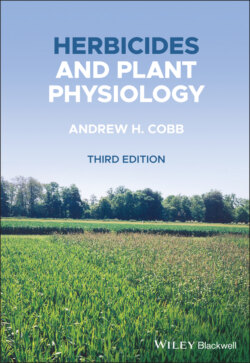Читать книгу Herbicides and Plant Physiology - Andrew H. Cobb - Страница 2
Table of Contents
Оглавление1 Cover
2 Title Page
3 Copyright Page
4 Preface References
5 Chapter 1: An Introduction to Weed Biology 1.1 Introduction 1.2 Distribution 1.3 The importance of weeds 1.4 Problems caused by weeds 1.5 Biology of weeds 1.6 A few examples of problem weeds 1.7 Positive attributes of weeds 1.8 The ever‐changing weed spectrum 1.9 Weed control References
6 Chapter 2: Herbicide Discovery and Development 2.1 Introduction 2.2 Markets 2.3 Prospects 2.4 Environmental impact and relative toxicology 2.5 Chemophobia 2.6 The search for novel active ingredients 2.7 The search for novel target sites 2.8 Mode of action studies 2.9 The role of natural chemistry 2.10 Recent developments 2.11 A lower limit for rates of herbicide application? References
7 Chapter 3: Herbicide Uptake and Movement 3.1 Introduction 3.2 The cuticle as a barrier to foliar uptake 3.3 Physicochemical aspects of foliar uptake 3.4 Herbicide formulation 3.5 Uptake by roots from soil 3.6 Herbicide translocation from roots to shoots 3.7 A case study: the formulation of acids 3.8 The formulation of glyphosate 3.9 Further developments References
8 Chapter 4: Herbicide Selectivity and Metabolism 4.1 Introduction 4.2 General principles 4.3 Herbicide safeners and synergists References
9 Chapter 5: Herbicides that Inhibit Photosynthesis 5.1 Introduction 5.2 Photosystems 5.3 Inhibition at Photosystem II 5.4 Photodamage and repair of Photosystem II 5.5 Structures and uses of Photosystem II inhibitors 5.6 Interference with electron flow at Photosystem I 5.7 RuBisCo activase 5.8 How treated plants die 5.9 Chlorophyll fluorescence 5.10 Inhibition of photosynthetic carbon reduction in C4 plants References
10 Chapter 6: Inhibitors of Pigment Biosynthesis 6.1 Introduction: structures and functions of photosynthetic pigments 6.2 Inhibition of chlorophyll biosynthesis 6.3 Inhibition of carotenoid biosynthesis 6.4 Inhibition of plastoquinone biosynthesis 6.5 How treated plants die 6.6 Selectivity and metabolism 6.7 Summary References
11 Chapter 7: Auxin‐type Herbicides 7.1 Introduction 7.2 Structures and uses of auxin‐type herbicides 7.3 Auxin, a natural plant growth regulator 7.4 Biosynthesis and metabolism of auxins 7.5 Auxin receptors, gene expression and herbicides 7.6 Signal transduction 7.7 Auxin transport 7.8 Resistance to auxin‐type herbicides 7.9 An ‘auxin overdose’ 7.10 How treated plants die 7.11 Selectivity and metabolism References
12 Chapter 8: Inhibitors of Lipid Biosynthesis 8.1 Introduction 8.2 Structures and uses of graminicides 8.3 Inhibition of lipid biosynthesis 8.4 Activity of graminicides in mixtures 8.5 How treated plants die 8.6 Plant oxylipins: lipids with key roles in plant defence and development 8.7 Selectivity References
13 Chapter 9: The Inhibition of Amino Acid Biosynthesis 9.1 Introduction 9.2 Overview of amino acid biosynthesis in plants 9.3 Inhibition of glutamine synthase 9.4 Inhibition of aromatic amino acid biosynthesis 9.5 Inhibition of branch‐chain amino acid biosynthesis 9.6 Inhibition of histidine biosynthesis References
14 Chapter 10: The Disruption of Cell Division 10.1 Introduction 10.2 The cell cycle 10.3 Control of the cell cycle 10.4 Microtubule structure and function 10.5 Herbicidal interference with microtubules 10.6 Selectivity References
15 Chapter 11: The Inhibition of Cellulose Biosynthesis 11.1 Introduction 11.2 Cellulose biosynthesis 11.3 Cellulose biosynthesis inhibitors 11.4 How treated plants die 11.5 Selectivity References
16 Chapter 12: Plant Kinases, Phosphatases and Stress Signalling 12.1 Introduction 12.2 Plant kinases 12.3 Plant phosphatases 12.4 Cyclin‐dependent kinases and plant stress 12.5 Post‐translational modification of proteins References
17 Chapter 13: Herbicide Resistance 13.1 Introduction 13.2 Definition of herbicide resistance 13.3 How resistance occurs 13.4 A chronology of herbicide resistance 13.5 Mechanisms of herbicide resistance 13.6 Case study – black‐grass (A. myosuroides Huds) 13.7 Strategies for the control of herbicide‐resistant weeds 13.8 The future development of herbicide resistance References
18 Chapter 14: Herbicide‐tolerant Crops 14.1 Introduction 14.2 History of genetically modified, herbicide‐tolerant crops 14.3 How genetically modified crops are produced 14.4 Genetically engineered herbicide tolerance to glyphosate 14.5 Genetically modified herbicide tolerance to glufosinate 14.6 Genetically modified herbicide tolerance to bromoxynil 14.7 Genetically modified herbicide tolerance to sulphonylureas 14.8 Genetically modified herbicide tolerance to 2,4‐D 14.9 Genetically modified herbicide tolerance to fops and dims 14.10 Genetically modified herbicide tolerance to phytoene desaturase inhibitors 14.11 Herbicide tolerance owing to genetic engineering of enhanced metabolism 14.12 Herbicide tolerance through means other than genetic modification 14.13 Gene editing 14.14 Economic, environmental and human health benefits from the adoption of GM technology 14.15 Gene stacking 14.16 Will the rise of glyphosate be inevitably followed by a fall? 14.17 Why is there so much opposition to GM technology? 14.18 Future prospects References
19 Chapter 15: Further Targets for Herbicide Development 15.1 Introduction 15.2 Protein turnover 15.3 The promotion of ageing in weeds? 15.4 Herbicide leads at the apicoplast 15.5 Control of seed germination and dormancy 15.6 Natural products as leads for new herbicides References
20 Glossary
21 Index
22 End User License Agreement
